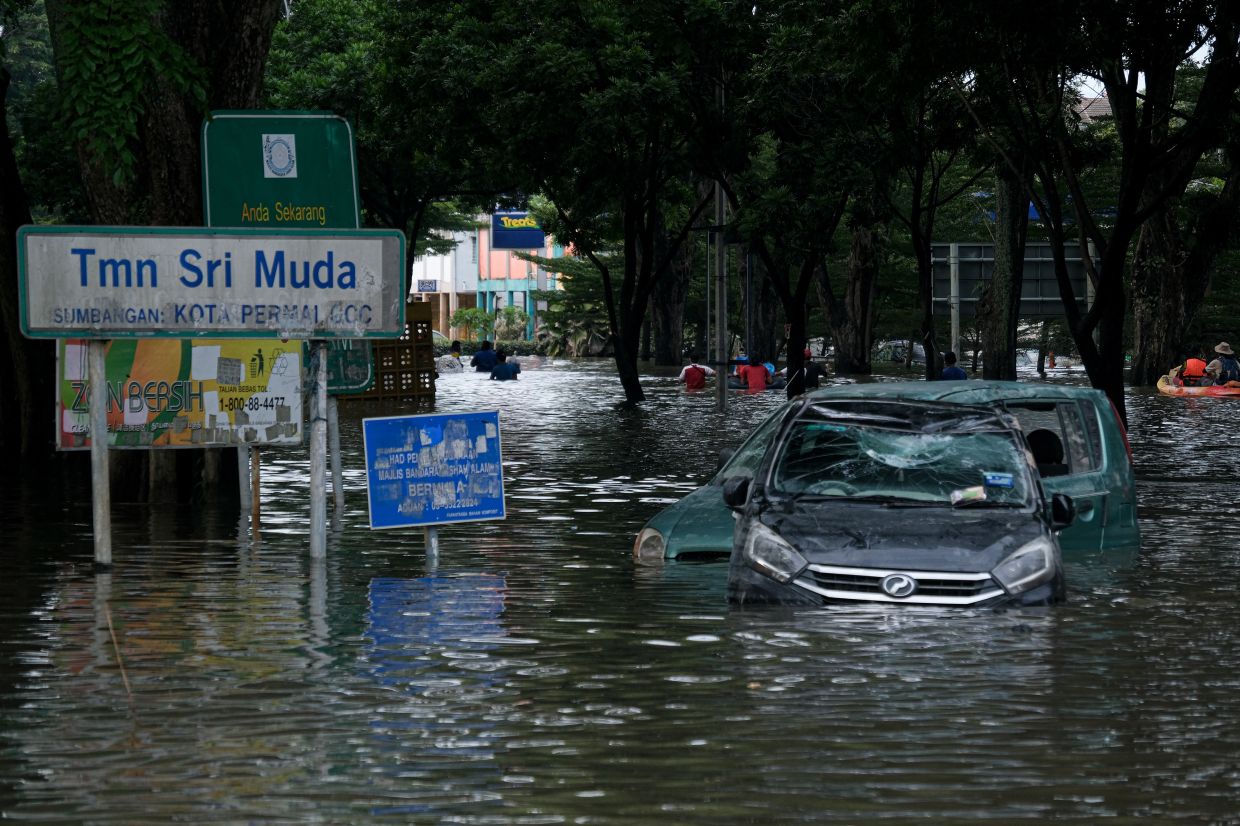
TAMAN Sri Muda is just a barely 15 minutes drive away from Shah Alam, the capital of Selangor. It is a major township located in the Klang district where, by logic, immediate help should have been efficiently swift to rescue the stranded flood victims.
It is not an isolated rural enclave, where accessibility is difficult, but a modern suburb with easy access to three highways. There is even a KTM station located about 2km away from Taman Sri Muda.
So, the range of excuses that has cropped up is hard to accept. It is pathetic, really. Not just to the affected residents but the whole of Malaysia.
Cries of help were still ringing even 48 hours after the floods hit the area, with victims having to spend overnight on rooftops without water and food in the cold.
Some were trapped on the top floor of their submerged homes or in stranded cars, but it made no difference. They had the same predicament, too.
There were many cases of calls for help, especially from families with children and old folks, and in one case, purportedly, the person had died in the home. When the power of their mobile phones died out, they became more desperate and frightened.
So, we are now told that this was an unexpected flood, which had caught everyone by surprise. A month’s rain in one day, we heard.
But for the residents of Taman Sri Muda and surrounding areas, they have been complaining of floods for over 20 years.
The elected representatives have come and gone, but nothing has changed, despite their electoral promises. They certainly have the right to be furious at the authorities – whether federal or state.
When floods hit the place on Dec 25, 1995, the residents took to task the authorities over the lack of planning and failure to render efficient rescue services.
Mind you, it was then on a much smaller scale compared to the one on Sunday (Dec 19), which was exceptional.
Then, on Dec 14, 2021, Malaysia was hit again by Tropical Depression, with Pahang and Selangor being the hardest hit. The media reported that government officials described it as “once in 100 years”. Well, the same excuse has now been given again.
And of course, Taman Sri Muda wasn’t spared in those floods, where damage was reported in Shah Alam.
While the floods in Malaysia are due to its geographical location, with cyclical monsoons characterised by heavy and regular rainfall from October to March, inadequate drainage in many urban areas has worsened the effects of heavy rain.
There have been consistent reports of floods in Klang Valley for areas along the Klang River, Gombak River, Kerayong River, and of course, Damansara River in Shah Alam, where Taman TTDI Jaya Giant Hypermarket and Shah Alam Stadium are located.
On Sunday, all these areas were the worst hit, and it doesn’t take an expert to tell us, given the notorious history of flooding in these areas, that we should have been better prepared – even if it wasn’t as bad as this latest one. Were we even prepared in these areas?
According to the authorities, 60,000 personnel from the police, army and fire department were mobilised nationwide. But ask the ordinary rakyat, they probably think differently and public perception is everything, like it or not.
What was glaring has been the lack of coordination and readiness to respond to a big disaster. What would have happened if there was something more massive than last Sunday’s flood?
But let me salute our rescue operations personnel for doing the best, in whatever circumstances, for their work. After all, they merely take commands.
Flood occurrences have become more frequent in recent years in urban areas because of the loss of flood storage due to development extending into and taking over flood plains and drainage corridors.
Then, there are inadequate drainage systems, or failure of localised drainage improvement works extended insufficiently downstream, according to www.water.gov.my.
There is also constriction at bridges and culverts that are either undersized or partially blocked by debris build-up or other causes.
To be fair, since 1971, following the setting up of the Permanent Flood Control Commission, to take various steps for flood control and to reduce the occurrence, including even flood forecasting and warning, but all failed last Sunday and in previous years.
Our politicians’ visits to these disaster areas have been dismissed cynically by Malaysians, especially in Selangor, and some have not even been seen in their constituencies.
It was a point made by His Royal Highness the Sultan of Selangor, Sultan Sharafuddin Idris Shah, in an interview with The Star recently – before Sunday’s floods – of some elected representatives in the state who only “talks a lot on social media and in Parliament but in reality, there is nothing done” and he was referring to flash floods which hit an area in Selangor a few months back.
Selangor’s biggest problem is the frequent water supply disruptions and constant floods. That’s bad.
Selangor is the most important state in the country, being the most industrialised, so it needs all the backing at all levels, including the Federal Government.
The rakyat is sick and tired of excessive politicking, finger-pointing, photo ops involving politicians, big ceremonies and finally, stop blaming God. It is neither God’s wrath for our purported sinful ways nor that Shah Alam has a brewery.
Please. It is no longer once in 100 years flooding anymore; it has become too frequent.





